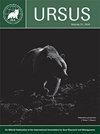哥伦比亚Chingaza山的安第斯熊胃肠道寄生虫
IF 0.8
4区 生物学
Q4 ZOOLOGY
引用次数: 0
摘要
摘要:安第斯熊(Tremarctos ornatus)是生活在南美洲安第斯山脉的熊科中唯一的一种。该物种的自然历史和与传染病有关的健康问题,特别是胃肠道寄生虫(GIP)的存在是未知的。为了确定野生安第斯熊粪便样本中GIP的流行程度、侵染程度和丰富度,于2019年2月至4月在哥伦比亚Chingaza国家公园及其缓冲区的不同地点收集了21份粪便样本。样品采用定性和定量同源技术进行分析。100% (n = 21)的样本中至少存在一种寄生虫,其中86%的样本检测到合并感染。观察到的寄生虫流行率由高到低依次为:隐孢子虫100%;蛔虫62%;贝氏蛔虫38%;滴虫33%;圆线虫占19%;小孢子虫和球虫卵囊14%;其次是毛线虫和纤毛原生动物,占10%;5%的标本中检出钩虫、囊虫和片形吸虫。囊虫、贝氏蛔虫、蛔虫和隐孢子虫的存在表明可能存在家养和野生宿主之间的寄生虫轮换。这是哥伦比亚东部安第斯熊的第一份GIP报告,这可能有助于在该国和南美洲开展其他研究。本文章由计算机程序翻译,如有差异,请以英文原文为准。
Andean bear gastrointestinal parasites in Chingaza Massif, Colombia
Abstract: The Andean bear (Tremarctos ornatus) is the only species of the Ursidae that inhabits the Andes in South America. The natural history of the species and health issues related to infectious diseases, particularly the presence of gastrointestinal parasites (GIP), is unknown. To determine the prevalence, infestation, and richness of GIP in fecal samples of wild Andean bears, 21 fecal samples were collected at different sites of the Chingaza National Park, Colombia, and its buffer area from February to April of 2019. Samples were analyzed by qualitative and quantitative coprological techniques. A minimum of one parasitic species was present in 100% (n = 21) of the samples and in 86% of them, co-infection was detected. In decreasing order, the observed parasite prevalence was as follows: 100% for Cryptosporidium spp.; 62% for Ascaris spp.; 38% for Baylisascaris spp.; 33% for Trichomonas spp.; 19% for Strongylus spp.; 14% for Microsporidia and Coccidian oocysts; followed by Trichostrongylus spp. and ciliated protozoans with 10%; and Ancylostoma spp., Blastocystis spp., and Fasciola spp. were present in 5% of the samples. The presence of Blastocystis spp., Baylisascaris spp., Ascaris spp., and Cryptosporidium spp. suggests a possible rotation of parasitic species between domestic and wild host species. This is the first report of GIP for Andean bears in the east range of Colombia, which could help to generate other studies in the country and South America.
求助全文
通过发布文献求助,成功后即可免费获取论文全文。
去求助
来源期刊

Ursus
生物-动物学
CiteScore
2.00
自引率
15.40%
发文量
12
审稿时长
>12 weeks
期刊介绍:
Ursus includes a variety of articles on all aspects of bear management and research worldwide. Original manuscripts are welcome. In addition to manuscripts reporting original research, submissions may be based on thoughtful review and synthesis of previously-reported information, innovative philosophies and opinions, and public policy or legal aspects of wildlife conservation. Notes of general interest are also welcome. Invited manuscripts will be clearly identified, but will still be subject to peer review. All manuscripts must be in English. All manuscripts are peer-reviewed, and subject to rigorous editorial standards.
 求助内容:
求助内容: 应助结果提醒方式:
应助结果提醒方式:


